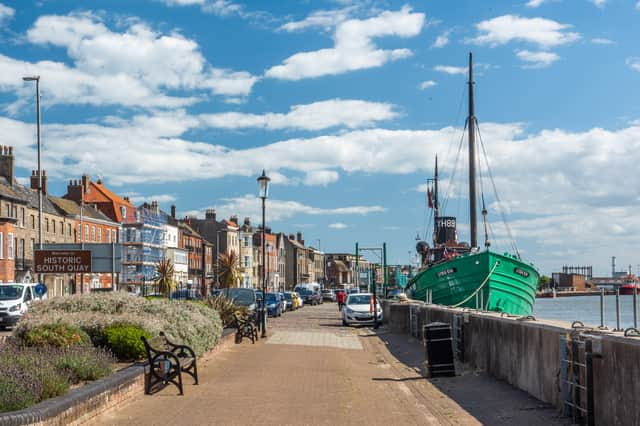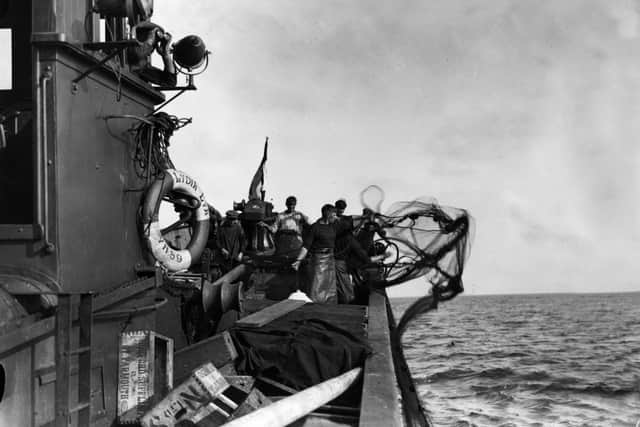Wonka's boat: The fascinating real-life story of the Lydia Eva of Great Yarmouth, which appears in new film
The first thing you see in one of the trailers for the new Wonka film is a boat looming through the fog.
It’s the vessel which has, so the story goes, transported the future genius chocolatier around the world learning the art of sweet treats, and then brings him to Europe to set up his famous company. The trailer later gives a glimpse of chocolate that makes people levitate, flocks of flamingoes, giraffes running wild and - of course - a Oompa Loompa who looks a lot like Hugh Grant. Many people may assume that the boat is just another CGI part of a movie but the Lydia Eva is very much real and while her story may not - quite - match that level of phantasmagoria it is nonetheless fascinating.
Advertisement
Hide AdAdvertisement
Hide AdIn real life Mr Wonka’s boat spends most of her time moored on the historic South Quay of the River Yare at Great Yarmouth, although she is very much a living vessel, and indeed holds the proud title of the last working steam drifter in the world. She needed a million-pound fundraising push in the first years of this century to get her back to seaworthiness, but even that fairytale story didn’t prevent those in charge of her being taken aback by her first steps into cinema.


“We thought it was a hoax,” laughs Ernie Artis, the ship’s manager and vice chairman of the Lydia Eva and Mincarlo Trust, which looks after her now, as he recalls the first contact from Wonka contractors in 2021.
“During the pandemic we received emails which we thought were a hoax, from an agent who tracks boats down for films. After a few emails which we ignored we spoke to him and he said that the boat had been chosen and would we like to take it to Lyme Regis.”
The trip down to the south coast caused some issues - with broken-down tugs and the like - but eventually Lydia Eva made it to Dorset, although she never managed to sail into Lyme as hoped because the weather was too bad. And sadly, after she was tugged in, she suffered some scrapes and sprang a leak while she was there.
Advertisement
Hide AdAdvertisement
Hide Ad“We were told she would be afloat in Lyme Regis but Lyme Regis dries out,” Ernie added. “The bow was afloat but the stern was not, even in high water. We had to get her in dry dock when she came back. She was 14 days in dry dock to find the leak.”
But despite the mishaps everyone at the trust is delighted that the 93-year-old ship is getting international limelight. “We’ve seen the trailer of the film,” said Ernie. “The film company had to come back to Yarmouth to shoot the engine running. [It was supposed to be done secretly but] we cheated because we told the local press and television to come down, but the film company did let them take pictures. Now we’re waiting for the film to come out on December 8. The first 10 seconds are in Lyme Regis.
“We were hoping that the film was going to come out in March, as our season normally starts on April 1, but we are hoping to be able to capitalise on it.”
And Ernie only has one regret: “We should have charged them more! But we’re now on the radar for other films and we might get another shot. We’ve had one or two inquiries from one or two TV companies through the year.”
Advertisement
Hide AdAdvertisement
Hide AdFor more about the Lydia Eva see here, and for more about Great Yarmouth click here.
The Lydia Eva's history
Lydia Eva's working life started in 1930, when she was launched by her namesake, Lydia Eva, the daughter of her owner Harry Eastwick. She was designed by Crabtree and Co of Great Yarmouth and was to work in the town’s internationally famous herring industry - as well as playing a part in the east coast’s herring season in the second half of the year with drifting, she would catch plaice and sole as well. Fishing was a hard life, with long hours spent at sea. And it wasn't just tough for the fishermen - those working ashore, such as women gutting tens of thousands of herring struggled to make much of a living - even though the fish they processed was famed around the world.


However, she only served as a fishing boat for eight years, being then sold in 1939 toa boatyard in Pwllheli in north Wales, and was used for maintaining buoys and salvage work. She's not thought to have seen active wartime service but was used around the country by the military, becoming a familiar site in the Bristol Channel while based at Ilfracombe, Maryport in Cumbria, Weymouth in Dorset and Whitehaven back in Cumbria, also picking up the new name Watchmoor during this time.
She was put up for sale in 1969, and bought by The Maritime Trust. After a restoration she headed back to her original home port of Great Yarmouth in 1972, and quickly became a tourist attraction. You’d be forgiven for thinking that that would be her happy ending. But no, in the late 1970s The Maritime Trust decided to move all its boats to one place- St Katherine’s Dock in London, and so Lydia Eve said farewell. But the costs didn’t add up and in 1986 the collection was closed… meaning she was brought back to Yarmouth in 1990. However, the initial joy at the homecoming waned slightly when in 1999 it became clear that she needed an overhaul - and so a new fundraising push was launched. A million pounds later and she was ready to steam again for the first time since the late 1970s, and now is regularly seen heading out to sea.
Comment Guidelines
National World encourages reader discussion on our stories. User feedback, insights and back-and-forth exchanges add a rich layer of context to reporting. Please review our Community Guidelines before commenting.